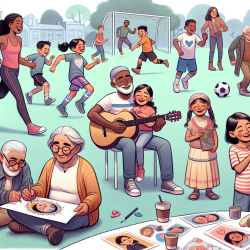Introduction
As practitioners dedicated to improving child outcomes, it is imperative to integrate data-driven strategies that promote holistic health. The research article "It still takes a village: Advocating healthy living medicine for communities through social justice action" highlights the significance of healthy living medicine (HLM) in advancing health equity, particularly in historically marginalized communities. This blog explores how practitioners can leverage these insights to enhance their skills and advocate for better health outcomes.
Understanding Healthy Living Medicine (HLM)
HLM emphasizes the importance of physical activity, good nutrition, maintaining a healthy body weight, and avoiding smoking. The research underscores that these strategies are crucial for improving health outcomes in communities disproportionately affected by chronic diseases. Practitioners can adopt these principles to foster environments where children and their families can thrive.
Implementing Social Justice in Practice
Social justice action is vital for addressing health disparities. The research advocates for community collaboration to promote physical activity and healthy living. Practitioners can engage with community leaders, schools, and families to create programs that are culturally relevant and accessible. This collaborative approach ensures that interventions are tailored to the unique needs of each community.
Data-Driven Decision Making
Data is crucial for evaluating the effectiveness of interventions. Practitioners should collect and analyze data on physical activity levels, nutritional habits, and health outcomes within their communities. This information can guide the development of targeted interventions and measure progress over time. By using data to inform decisions, practitioners can ensure that their efforts are impactful and sustainable.
Encouraging Further Research
The research highlights the need for continued exploration of culturally tailored interventions. Practitioners are encouraged to conduct further research on the barriers and facilitators of healthy living in diverse communities. This research can inform the development of innovative strategies that address the root causes of health disparities.
Conclusion
By integrating the principles of HLM and social justice into their practice, practitioners can play a pivotal role in advancing health equity. Collaborative efforts, informed by data and ongoing research, are essential for creating environments where children can achieve optimal health outcomes. To read the original research paper, please follow this link: It still takes a village: Advocating healthy living medicine for communities through social justice action.










